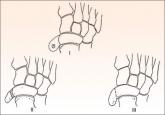Article

Excision of Symptomatic Spinous Process Nonunion in Adolescent Athletes
- Author:
- Murphy RF
- Hedequist D
While clay-shoveler’s fractures in athletes are usually treated conservatively with rest, activity modification, and return to activities when...
Article

Surgical Treatment of Symptomatic Accessory Navicular in Children and Adolescents
- Author:
- Pretell-Mazzini J
- Murphy RF
- Sawyer JR
Although an accessory navicular (AN) is present in approximately 10% of the population, it rarely is symptomatic, and few cases necessitate...
